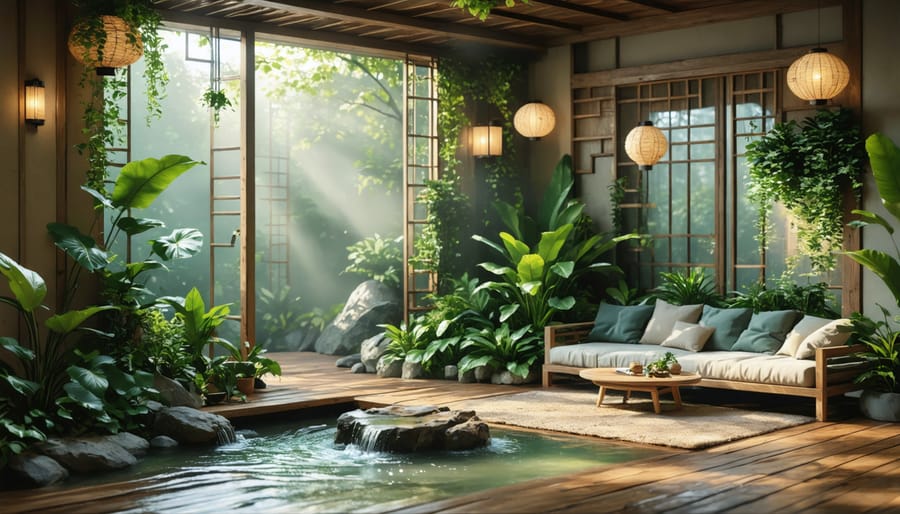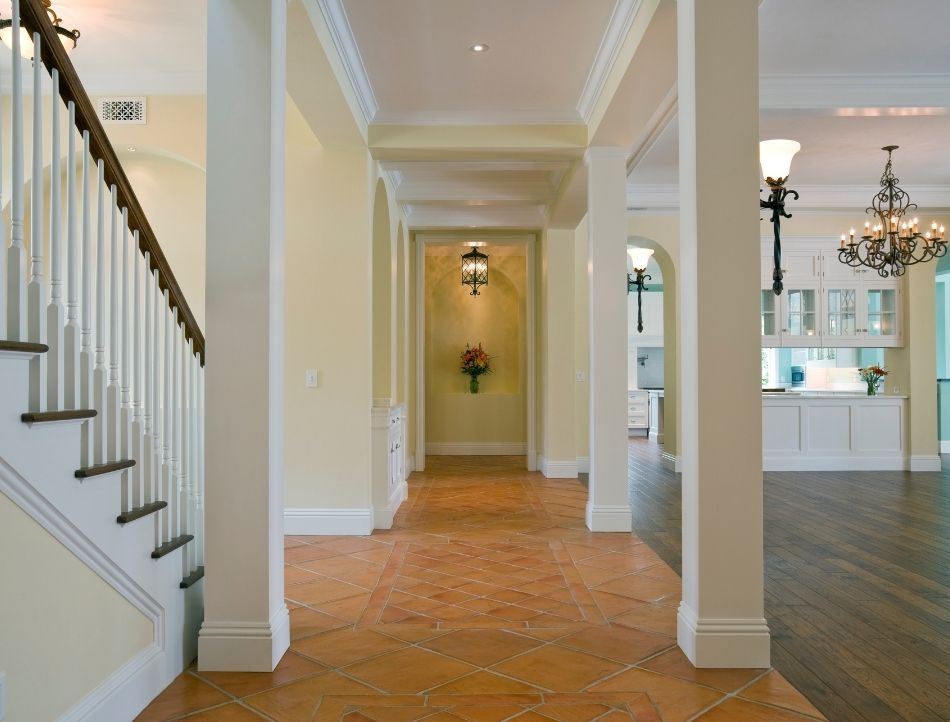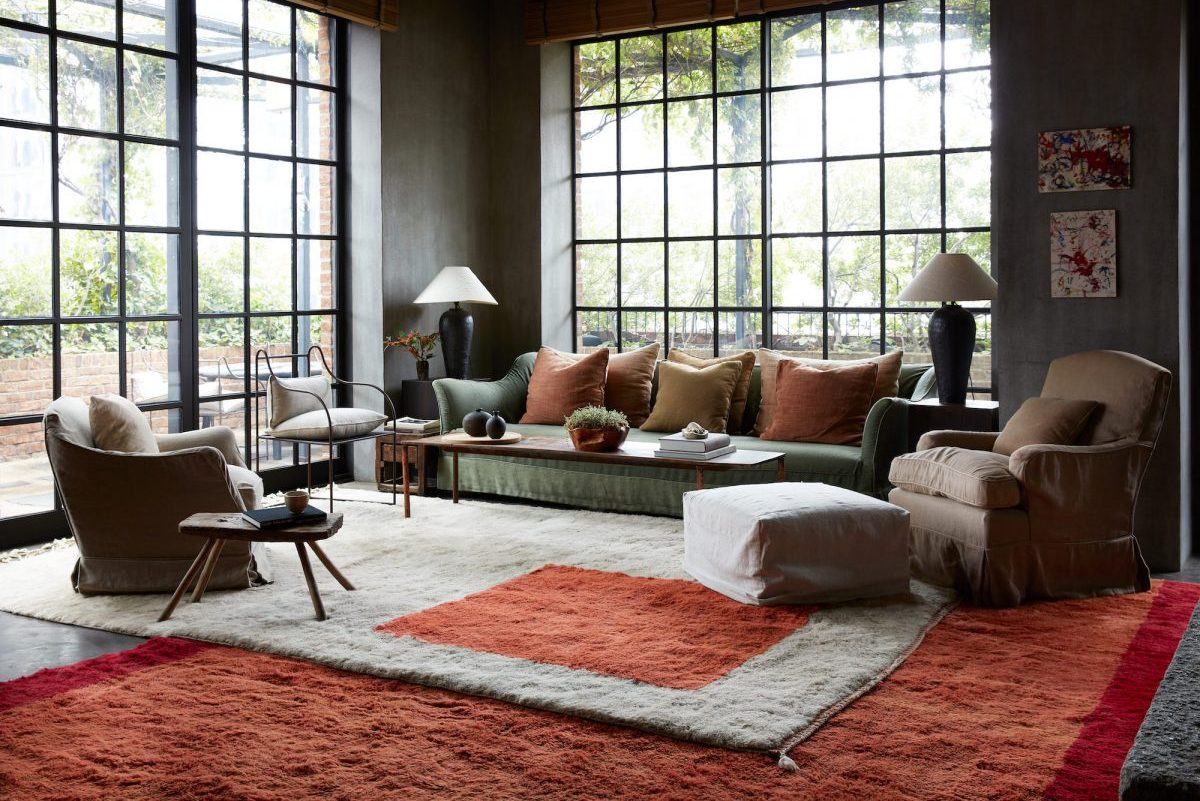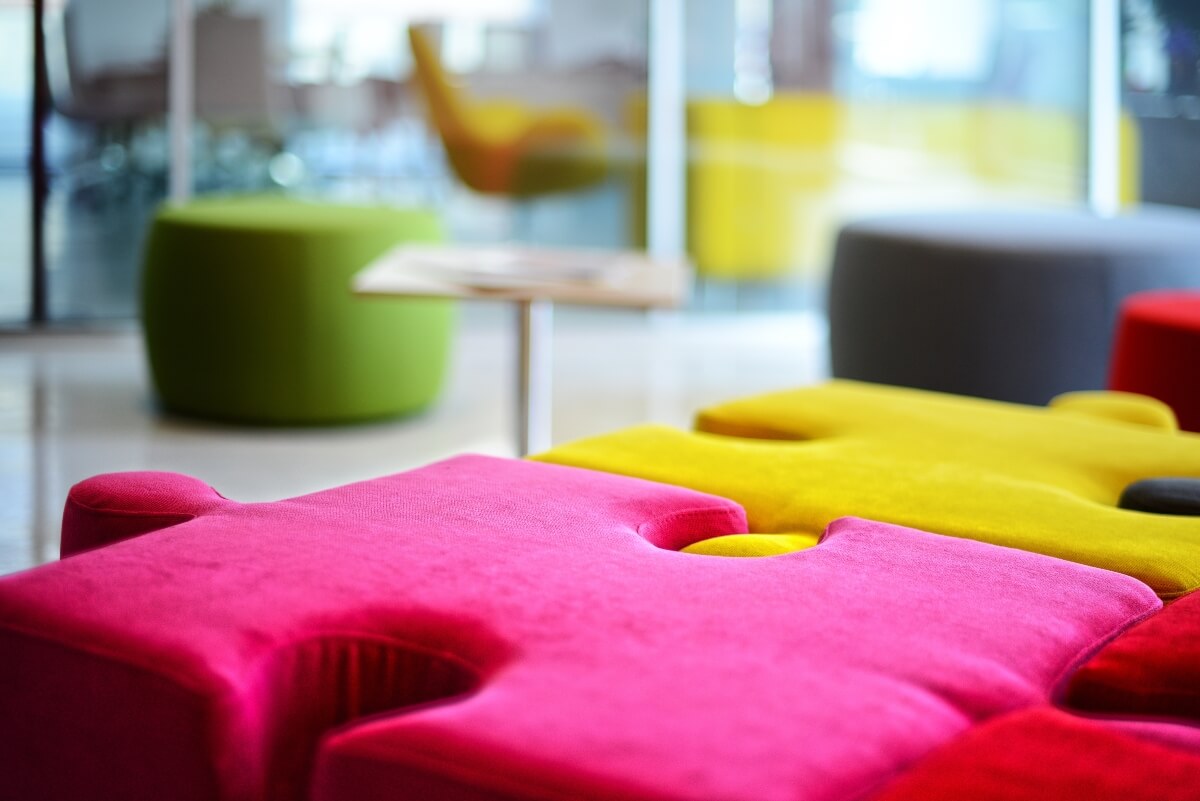Transform your living space into a natural sanctuary by incorporating the five essential elements – earth, water, fire, air, and space – into your daily environment. Scientific studies have shown that connecting with these primal forces can reduce stress levels by up to 60% while boosting overall well-being and mental clarity. Through thoughtful design choices and strategic placement of natural materials, you can create a home that not only looks beautiful but actively contributes to your physical and emotional health.
From the grounding presence of stone features and wooden furnishings to the soothing sound of water fountains and the gentle movement of air through well-placed windows, natural elements therapy works by reconnecting us with the fundamental building blocks of nature. This time-tested approach combines ancient wisdom with modern design principles to address common challenges like anxiety, insomnia, and chronic stress – all while creating spaces that feel both luxurious and deeply nurturing.
Whether you’re redesigning an entire home or simply looking to enhance a single room, understanding how to harness these elemental forces can dramatically impact your living environment’s therapeutic potential. Let’s explore how you can bring this powerful healing modality into your everyday spaces.
The Science Behind Natural Elements in Interior Spaces
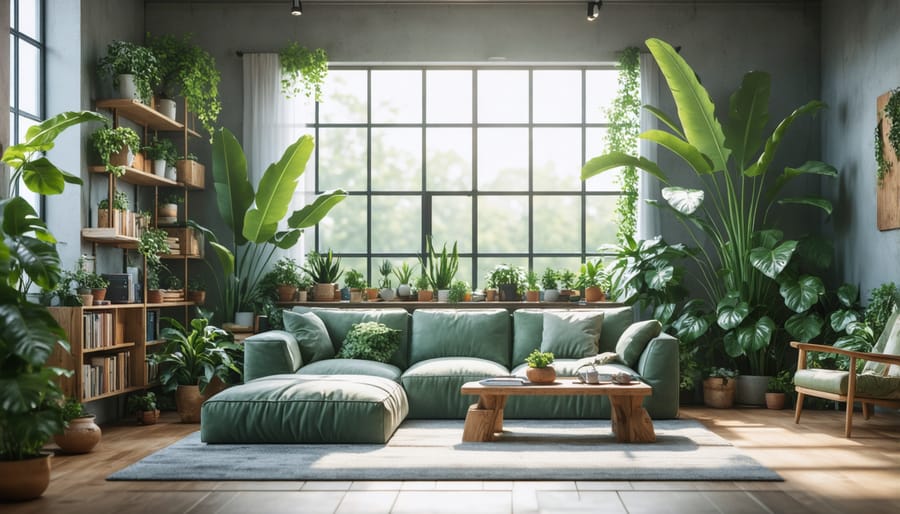
Biophilia and Human Well-being
Our deep-rooted connection to nature isn’t just a poetic notion – it’s hardwired into our DNA. This innate bond, known as biophilia, explains why we feel more relaxed walking through a park or why a simple houseplant can lift our spirits. As we’ve become increasingly disconnected from nature in our modern lives, incorporating biophilic design elements into our living spaces has become essential for our well-being.
Research shows that exposure to natural elements can lower blood pressure, reduce stress hormones, and improve mood and concentration. Even brief interactions with nature – like watching a sunset through your window or touching natural materials like wood – can trigger positive physiological responses. These benefits aren’t just temporary fixes; they contribute to long-term mental health improvements and overall life satisfaction.
By understanding and nurturing this connection to nature, we can create living spaces that not only look beautiful but also support our psychological and physical health in meaningful ways.
Stress Reduction Through Natural Design
Scientific research consistently shows that incorporating natural elements into our living spaces can significantly reduce stress levels and promote overall well-being. Studies have found that exposure to natural materials and designs can lower cortisol levels by up to 60% compared to purely artificial environments. The simple act of adding wooden furniture, stone accents, or indoor plants can trigger a biological response that helps calm our nervous system.
This stress-reducing effect is particularly noticeable in spaces that feature flowing water elements, such as small fountains or water features. The gentle sound of trickling water has been proven to lower blood pressure and heart rate within minutes of exposure. Similarly, natural light exposure through strategically placed windows or skylights helps regulate our circadian rhythm, reducing anxiety and improving sleep quality.
Green spaces, even when viewed through windows, can decrease stress hormones within 3-5 minutes of exposure. This explains why hospitals and wellness centers increasingly incorporate healing gardens and natural views into their designs. By bringing these elements into our homes, we can create personal sanctuaries that actively support our mental and emotional well-being through nature’s innate therapeutic properties.
Essential Natural Elements for Therapeutic Interiors
Natural Light and Its Impact
Natural light is one of the most powerful elements in creating a therapeutic home environment. Our bodies are naturally attuned to sunlight, which helps regulate our circadian rhythm – the internal clock that governs our sleep-wake cycle. To maximize natural light in your space, start by keeping windows clean and unobstructed. Consider removing heavy drapes in favor of sheer curtains or adjustable blinds that allow you to control light levels throughout the day.
Strategic furniture placement can help bounce light deeper into your rooms. Position mirrors opposite windows to reflect and amplify natural light, and opt for lighter wall colors to enhance brightness. If possible, create a dedicated morning routine space near a window where you can soak in early sunlight, which helps boost serotonin levels and improve mood.
For rooms with limited natural light, consider installing skylights or solar tubes. Even small changes, like trimming outdoor foliage that blocks windows or rearranging workspace to face natural light sources, can significantly impact your daily well-being. Remember to balance bright light exposure during the day with darker environments in the evening to maintain healthy sleep patterns.
Indoor Plants and Air Quality
Indoor plants do more than just beautify your space – they’re natural air purifiers that can significantly improve your indoor air quality and boost your mental well-being. When it comes to styling indoor plants, choose varieties known for their air-cleaning properties.
Snake plants and spider plants are excellent choices for beginners, as they’re hardy and effective at removing common indoor pollutants. Peace lilies are particularly good at filtering out benzene and formaldehyde, while Boston ferns help maintain healthy humidity levels. The popular monstera deliciosa not only makes a striking statement piece but also helps reduce stress levels through its natural green presence.
For maximum benefit, place one medium-sized plant per 100 square feet of indoor space. Focus on areas where you spend most of your time, like your home office or bedroom. Remember that plants thrive best in well-lit areas with proper air circulation, though many air-purifying varieties can adapt to lower light conditions. Regular maintenance, including proper watering and occasional dusting of leaves, ensures your plants remain healthy and effective air purifiers.
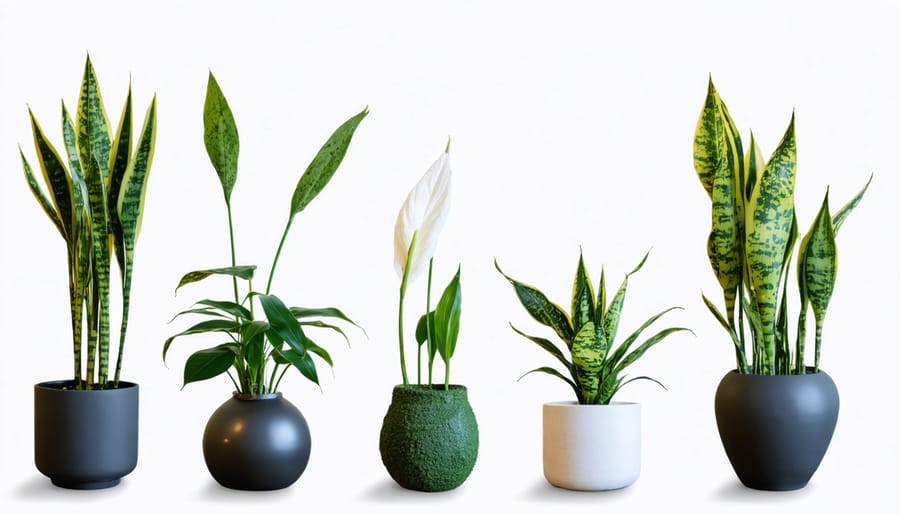
Natural Materials and Textures
Natural materials and textures serve as fundamental building blocks in creating a therapeutic environment that resonates with our innate connection to nature. By incorporating eco-friendly natural materials like reclaimed wood, river stones, and bamboo, you can transform any space into a calming sanctuary.
Consider adding wooden elements through furniture pieces, exposed beams, or decorative wall panels. The warmth and organic patterns of wood grain can help reduce stress and create a grounding effect. Natural stone, whether used in flooring, accent walls, or decorative elements, brings a timeless, earthy quality that promotes stability and peace.
Other therapeutic textures to explore include jute rugs, cotton throws, and woven baskets. These tactile elements not only please the eye but also engage our sense of touch, creating a multi-sensory experience that enhances relaxation. For maximum impact, mix different natural textures while maintaining a cohesive color palette of earth tones and neutral shades.
Remember to choose materials that are both sustainable and authentic – synthetic imitations won’t provide the same therapeutic benefits as genuine natural elements.
Water Features and Sound Therapy
The gentle sound of flowing water has an almost magical ability to calm our minds and reduce stress. Whether it’s the soft trickle of a tabletop fountain or the steady flow of a wall-mounted water feature, incorporating water elements into your living space can create a peaceful sanctuary that promotes relaxation and mental clarity.
Indoor water features come in various sizes and styles, from compact desktop fountains perfect for home offices to larger floor installations that serve as stunning focal points. The key is choosing one that matches both your space and lifestyle. For maximum therapeutic benefit, place your water feature in an area where you spend time unwinding, such as your living room or bedroom.
Beyond their visual appeal, water features provide natural white noise that can mask disruptive sounds from traffic or neighbors. This acoustic benefit is particularly valuable in urban environments, helping to create a more serene atmosphere. To enhance the calming effect, consider adding smooth river rocks or bamboo elements to your water feature, as these natural materials can create varied and pleasing water sounds.
For maintenance, use filtered water and clean your fountain regularly to ensure optimal performance and prevent mineral buildup. This simple care routine will keep your water feature operating smoothly while continuing to provide its therapeutic benefits.
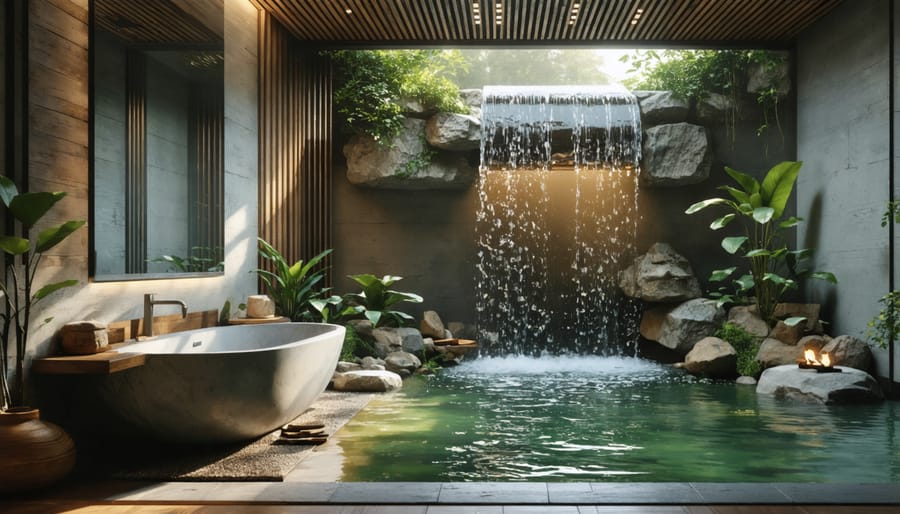
Practical Implementation Tips
Budget-Friendly Natural Elements
Incorporating natural elements into your space doesn’t have to break the bank. With some creativity and smart shopping, you can bring the outdoors in while staying within budget. Start by collecting interesting branches, pinecones, and stones from nature walks – these free elements instantly add organic texture to any room. Consider growing herbs in upcycled containers by your kitchen window, providing both natural decor and fresh ingredients for cooking.
Thrift stores and flea markets are excellent sources for affordable botanical prints and natural fiber baskets. You can create stunning wall art by pressing and framing leaves or flowers, or arrange found driftwood pieces as sculptural elements. When creating a cozy atmosphere, opt for affordable cotton or jute textiles in earth tones.
Consider growing low-maintenance houseplants from cuttings – many plant enthusiasts are happy to share. Spider plants, pothos, and succulents are particularly easy to propagate. Use natural light strategically by keeping windows clean and arranging furniture to maximize sunlight exposure. For texture, try adding rice or beans to clear glass containers, or create a zen garden using sand and small stones in a shallow tray.
Remember that natural elements can be rotated seasonally – displaying spring blooms, summer shells, autumn leaves, or winter evergreen branches keeps your space fresh while remaining cost-effective.
Room-by-Room Implementation Guide
Transform each room in your home into a natural sanctuary with these space-specific recommendations:
Living Room: Incorporate large potted plants in corners and hanging plants near windows. Use natural wood furniture and stone accents. Position seating to face windows, maximizing natural light exposure. Add textural elements like woven baskets and wool throws.
Bedroom: Place small air-purifying plants like snake plants or peace lilies on nightstands. Use organic cotton bedding and natural fiber curtains. Install a small tabletop water fountain for soothing sounds. Consider a Himalayan salt lamp for soft, natural lighting.
Kitchen: Grow fresh herbs in window boxes or on countertops. Display fruits and vegetables in wooden bowls. Use natural stone or wood cutting boards as functional decor. Install under-cabinet grow lights for year-round herb gardens.
Bathroom: Add moisture-loving plants like bamboo or orchids. Use natural stone tiles or wooden bath mats. Display shells, river rocks, or dried starfish. Consider a wooden shower bench or bath caddy.
Home Office: Position your desk near a window. Use a living wall or vertical garden as a backdrop for video calls. Include small succulents on your desk. Add a natural wood desk organizer and cork board.
Remember to consider the natural light patterns in each room when positioning plants and selecting materials. Start with one room and gradually expand your natural elements throughout your home.
Maintenance and Long-term Benefits
Maintaining natural elements in your home isn’t just about keeping plants alive or dusting stone features – it’s about creating sustainable wellness that grows with you. Start by establishing a simple maintenance routine: water plants according to their specific needs, clean natural stone surfaces with appropriate solutions, and regularly dust wooden elements to preserve their beauty.
For living elements like indoor plants, rotate them every few weeks to ensure even growth and prune dead leaves promptly. Consider using a humidity tray for tropical plants and checking soil moisture weekly. Natural water features require periodic cleaning and water replacement to prevent algae growth and maintain optimal functioning.
The long-term benefits of maintaining these elements extend far beyond aesthetics. Regular interaction with natural elements has been shown to reduce stress levels, improve air quality, and create a more balanced home environment over time. Many people report better sleep patterns, increased productivity, and enhanced emotional well-being after consistently maintaining their nature-inspired spaces.
To maximize these benefits, gradually introduce new natural elements as you become comfortable maintaining existing ones. This approach helps create a sustainable relationship with your therapeutic space while preventing overwhelming maintenance duties. Remember, the goal is to create a living, breathing environment that continues to nurture your well-being for years to come.
Some elements, like stone or wood features, may actually become more beautiful with age, developing a natural patina that adds character to your space. This aging process, when properly maintained, contributes to the authentic, grounding nature of your therapeutic environment.
Bringing natural elements into your living space isn’t just about aesthetics – it’s a powerful way to enhance your well-being and create a more balanced life. By incorporating elements like natural light, indoor plants, wooden furniture, and flowing water features, you can transform your home into a therapeutic sanctuary. Start small by adding a few potted plants or opening your curtains wider, then gradually introduce more natural elements as you become comfortable with the changes. Remember that every step toward a more nature-connected home is a step toward better physical and mental health. The beauty of natural elements therapy lies in its accessibility – you can begin today with whatever resources you have available. Take that first step toward creating your own healing space, and watch as the power of nature transforms your home and well-being.

